Happy Wednesday! Halfway through another week of summer!
We’re almost finished with the kids’ embroidery classes, which end this Friday. I’ll share some photos – along with a discussion of what worked, what could have worked better, what we learned, and what we’d do differently – once we get things tied up.
In the meantime, today, here’s a nice piece of figure embroidery for you. It’s a “salvaged saint” – a piece of church embroidery that survived, when the vestment it was on didn’t. While I was in New England earlier this year, I visited a convent, where this was hanging in their “embroidery room” where they house all their machine embroidery supplies and tools.
I like her! She is St. Hedwig.
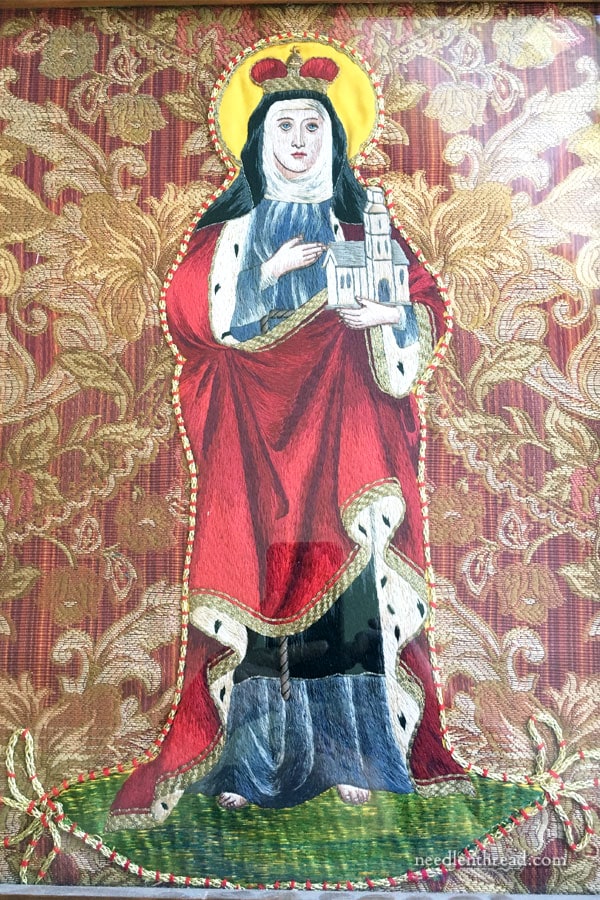
To salvage St. Hedwig from the garment that couldn’t support the embroidery anymore, she was removed carefully and then appliquéd onto a nice brocade ground fabric, which was then stretched and framed.
The appliqué process included couching gold around the outline of the figure, to give it a finished edge.
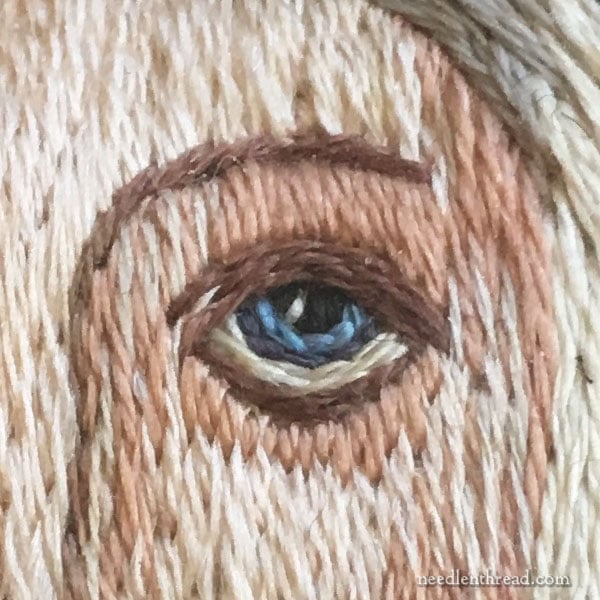
St. Hedwig is a completely embroidered figure.
From the mid-1800’s forwards, it wasn’t uncommon for ecclesiastical figure embroidery to be made up of different parts, like larger pieces of appliquéd fabric for clothing, and painted faces and hands, which were all then highlighted with sketchy embroidery to give them impression of an wholly embroidered piece. You can see this approach on this piece of figure embroidery that I’m currently salvaging.
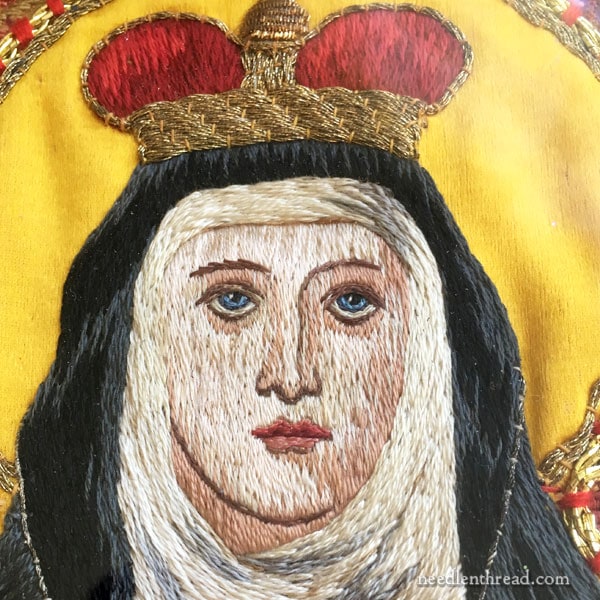
I love coming across a fully embroidered figure, because it gives me (and you!) a chance to see, up close, the shading and the stitch direction. It’s a nice way to get ideas how embroidering human figures.
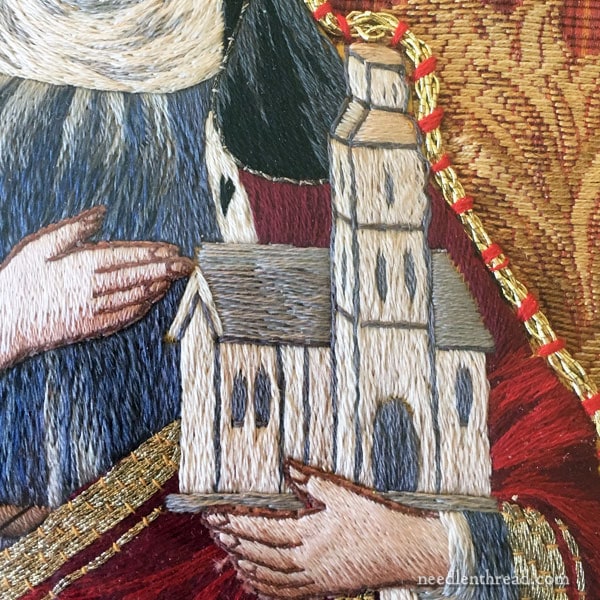
You can see here the delicate shading on the hands, the heavier shading on the church St. Hedwig is often depicted holding, and the shading on the clothing – which, admittedly, is my favorite aspect of this piece!
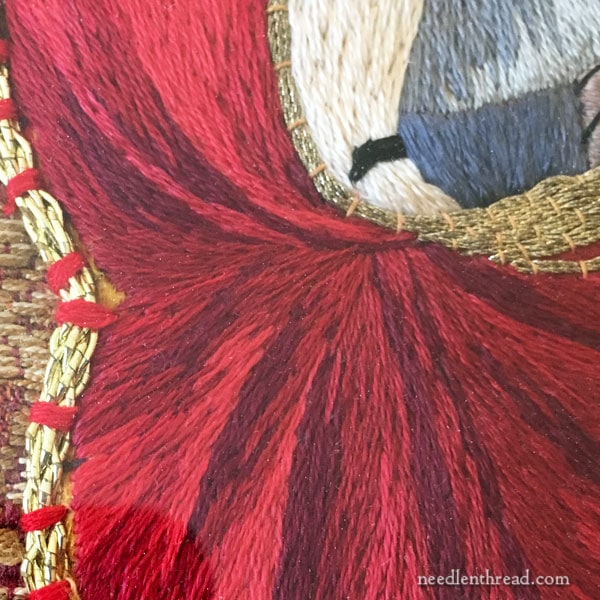
I love the way the garments flow, thanks to some nicely executed stitching! The highlights and shadows are really exquisite.
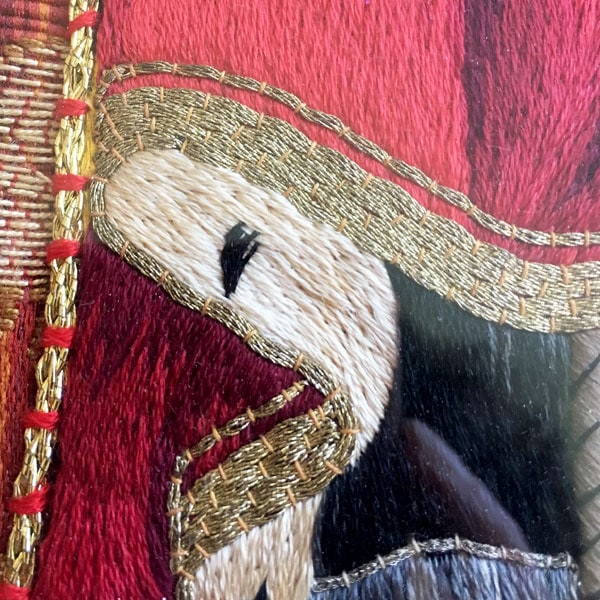
Here’s a bit of detail on the ermine, and the couched bunches of gold thread bordering the garments. You can also get an idea of the gold thread used to outline the whole piece when it was appliquéd to new fabric.
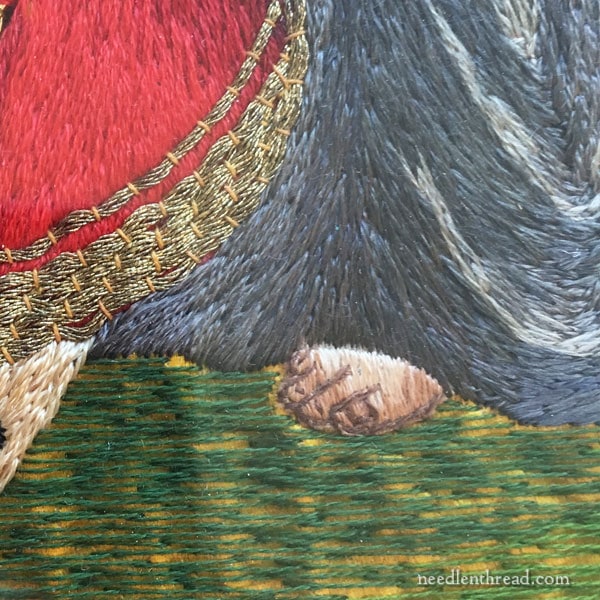
And of course, who doesn’t like saints’ toes? I always check out the feet that peak below the robes in figure embroidery, for some reason! It’s kind of like the folks who like to check out the toes of a newborn baby…
I always figure that the attention paid to detail, even on the toes, is a good indication that the piece was done with skill and a real dedication to the embroidery.
So that’s St Hedwig. If you’re curious about who she was and what she’s known for, this is a fairly detailed article about her life in 12th/13th c. Poland.
Hope you’re enjoying your midweek, and next time we meet, I hope to show you some photos of embroidery class results with the kids!







What a delight to look at and an interesting read. Thank you
It’s interesting that the replacement outline is couched in scarlet instead of the more common gold. I wonder why the stitcher that salvaged this made that choice.
It’s very common, on ecclesiastical work, to couch gold with red. I think they probably just matched the red in this case with red in the figure.
Interesting. Your gold work is the first I’ve really looked at up close, so I thought that the yellow gold couching was the standard. I’m learning!
I do find it interesting that the person who did the salvage handled the bottom corners in a way that ties into the shapes in the new background. That’s a lovely brocade and it is obvious that they were very careful in the placement of the figure on the new ground.
Hi Mary,
This is exquisite. Thanks for sharing it with us. What are the dimensions? I’m always astounded at the amount of shading and the depth of expression in such small spaces.
I think she’s about 14” – 16” high.
Dear Mary
This is a lovely portrait of the embroidered figure of St Hedwig, I’ve not heard of her before but then I’m not familiar with Saints, I read the detailed biography of her life which you included a really captivating story of her life and the times she lived in, such an unselfish person. I love the embroidered figure of her especially the eyes/hands/toes I’m sure it would have looked wonderful when it was first embroidered with the goldwork. But my favourite is part of the embroidery is St Hedwig holding the Church very poignant, thanks for sharing with us the embroidered portrait of St Hedwig and the link to her life and times very interesting.
Regards Anita Simmance
Could you please share the overall size of the St. Hedwig embroidery? Thanks!
She’s probably about 14” – 16” high
I love her, too. Those eyes … lovely.
One question: just above the blue skirt, reaching into the red garment, pretty much smack-dab in the centre, there is a rectangular shape, almost like a shadow or reflection. Any idea what it is?
Looking forward to your reflections on the kids’ classes!
Cheers!
It’s the reflection of my phone. :-/
Mary,
This is absolutely beautiful. The detail of each stitch is amazing. Is this mainly using long/short stitch?
Thank you for sharing this work of art; it brings inspiration in so many ways.
Shari
This piece is a magnificent piece of embroidery! As you point out, the subtly of shading is exquisite! Thank you for the close-up of the eye! Wow! I cannot even imagine!…….
What a lovely piece of embroidery Mary! I have a confession to make regarding the toes of Mary with baby Jesus…. My student worked the embroidery after a wood sculpture. The sculpture had, let’s say, interesting toes :). We could find no way of doing them in thread and thus decided that Mary’s hem was just that little bit longer!
This is so beautiful! Thank you for sharing her and her story <3
Why is she not holding a snowy owl? ; -)
Ha! Yeah, St. Hedwig’s been around a bit longer than that. And I think she has a bit more going for her than a character in Harry Potter… to say the least!
I would love to stitch St. Hedwig. How is it possible to get this image to transfer onto linen? Thank you
Rita